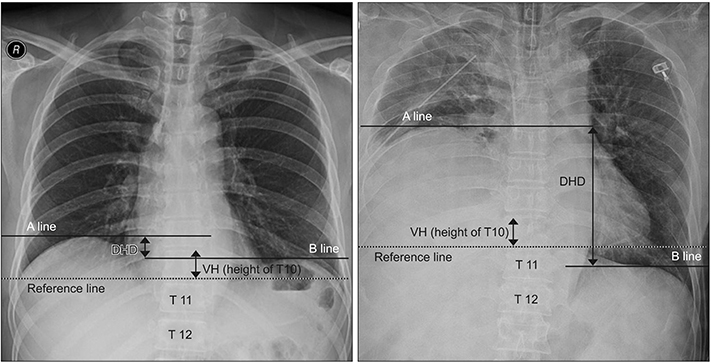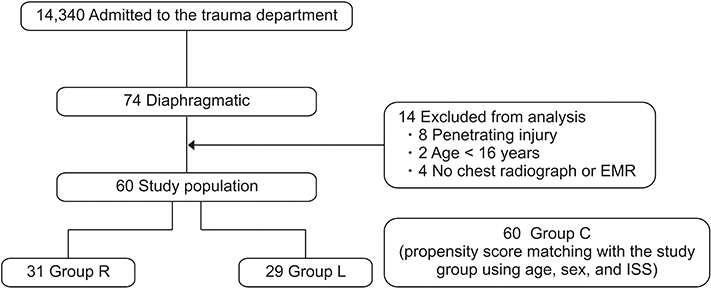Ann Surg Treat Res.
2019 Jul;97(1):36-40. 10.4174/astr.2019.97.1.36.
Diagnostic significance of diaphragmatic height index in traumatic diaphragmatic rupture
- Affiliations
-
- 1Department of Trauma Surgery, Ajou University School of Medicine, Suwon, Korea. soyo1226@naver.com
- KMID: 2450988
- DOI: http://doi.org/10.4174/astr.2019.97.1.36
Abstract
- PURPOSE
Traumatic diaphragmatic rupture resulting from blunt trauma is usually severe. However, it is often overlooked during initial evaluation because there are no characteristic signs and symptoms. Thus, this study aimed to determine the clinical characteristics of diaphragmatic rupture caused by blunt trauma and investigate the diagnostic usefulness of diaphragmatic height index (DHI) measured using chest radiographs.
METHODS
The cohort comprised patients who were admitted due to diaphragmatic rupture from blunt trauma. Patients were divided into 2 groups; the control group comprised patients with blunt trauma who were matched for age, sex, and Injury Severity Score, while the DHI group comprised patients with diaphragmatic rupture from blunt trauma. Receiver operating characteristic curve was used to determine the cutoff value of DHI for diaphragmatic injury. The sensitivity, specificity, predictability, accuracy, and likelihood ratio of the cutoff were then determined.
RESULTS
A total of 60 patients were confirmed to have diaphragmatic rupture. The mean DHI in patients with diaphragmatic rupture on the right and left side were both significantly different compared to that in the control group. A DHI cutoff value of >1.31 showed 71% sensitivity and 87% specificity for diagnosing right diaphragmatic rupture, while a cutoff value of <0.43 showed 87% sensitivity and 76% specificity for diagnosing left diaphragmatic rupture.
CONCLUSION
DHI can be useful in the diagnosis of diaphragmatic rupture. DHI as determined using chest radiographs in patients with blunt abdominal trauma, particularly in those ineligible for diagnostic work-up, may help in the diagnosis of diaphragmatic rupture.
Keyword
MeSH Terms
Figure
Reference
-
1. Hahn DM, Watson DC. Tension hydropneumothorax as delayed presentation of traumatic rupture of the diaphragm. Eur J Cardiothorac Surg. 1990; 4:626–627.
Article2. Montresor E, Procacci C, Guarise A, Minniti S, Bortolasi L, Nifosi F, et al. Strangulated traumatic hernia of the diaphragm. A report of two cases. Chir Ital. 1999; 51:471–476.3. Miller L, Bennett EV Jr, Root HD, Trinkle JK, Grover FL. Management of penetrating and blunt diaphragmatic injury. J Trauma. 1984; 24:403–409.
Article4. Toombs BD, Sandler CM, Lester RG. Computed tomography of chest trauma. Radiology. 1981; 140:733–738.
Article5. Pornrattanamaneewong C, Limthongthang R, Vathana T, Kaewpornsawan K, Songcharoen P, Wongtrakul S. Diaphragmatic height index: new diagnostic test for phrenic nerve dysfunction. J Neurosurg. 2012; 117:890–896.
Article6. Desir A, Ghaye B. CT of blunt diaphragmatic rupture. Radiographics. 2012; 32:477–498.
Article7. Bocchini G, Guida F, Sica G, Codella U, Scaglione M. Diaphragmatic injuries after blunt trauma: are they still a challenge? Reviewing CT findings and integrated imaging. Emerg Radiol. 2012; 19:225–235.8. Iochum S, Ludig T, Walter F, Sebbag H, Grosdidier G, Blum AG. Imaging of diaphragmatic injury: a diagnostic challenge? Radiographics. 2002; 22(Spec No):S103–S116.
Article9. Mirvis SE, Shanmuganagthan K. Imaging hemidiaphragmatic injury. Eur Radiol. 2007; 17:1411–1421.
Article10. Nchimi A, Szapiro D, Ghaye B, Willems V, Khamis J, Haquet L, et al. Helical CT of blunt diaphragmatic rupture. AJR Am J Roentgenol. 2005; 184:24–30.
Article11. Hood RM. Traumatic diaphragmatic hernia. Ann Thorac Surg. 1971; 12:311–324.
Article12. Sukul DM, Kats E, Johannes EJ. Sixty-three cases of traumatic injury of the diaphragm. Injury. 1991; 22:303–306.
Article13. Shah R, Sabanathan S, Mearns AJ, Choudhury AK. Traumatic rupture of diaphragm. Ann Thorac Surg. 1995; 60:1444–1449.
Article14. Puffer P, Gaebler M. Traumatic diaphragmatic rupture in a forensic medicine autopsy sample. Beitr Gerichtl Med. 1991; 49:149–152.15. Sharma AK, Kothari SK, Gupta C, Menon P, Sharma A. Rupture of the right hemidiaphragm due to blunt trauma in children: a diagnostic dilemma. Pediatr Surg Int. 2002; 18:173–174.
Article16. Gelman R, Mirvis SE, Gens D. Diaphragmatic rupture due to blunt trauma: sensitivity of plain chest radiographs. AJR Am J Roentgenol. 1991; 156:51–57.
Article17. Hamidian Jahromi A, Pennywell D, Owings JT. Does a negative emergency celiotomy exclude the possibility of significant diaphragmatic injury? A case report and review of the literature. Trauma Mon. 2016; 21:e25053.
Article18. Beal SL, McKennan M. Blunt diaphragm rupture. A morbid injury. Arch Surg. 1988; 123:828–832.19. Collins J, Stern EJ. Chest radiology: The Essentials. 9th ed. Philadelphia: Lippincott Williams & Wilkins;2008. p. 1–15. Normal anatomy of the chest.20. Suwatanapongched T, Gierada DS, Slone RM, Pilgram TK, Tuteur PG. Variation in diaphragm position and shape in adults with normal pulmonary function. Chest. 2003; 123:2019–2027.21. Krige JE, Beckingham IJ. ABC of diseases of liver, pancreas, and biliary system. BMJ. 2001; 322:537–540.
- Full Text Links
- Actions
-
Cited
- CITED
-
- Close
- Share
- Similar articles
-
- Incidental traumatic right diaphragmatic rupture: a missed case after trauma
- Delayed Presentation of Traumatic Diaphragmatic Hernia
- Effects of Patient Controlled Analgesia with Morphine after Obstetric or Gynecologic SurgerAnesthesia for Traumatic Diaphragmatic Hernia Detected after Operation of the Femur Fracture
- Traumatic Bilateral Diaphragmatic Ruptures in a 6-Year-Old Boy
- A Case of Late Presentation of Traumatic Diaphragmatic Hernia in a Child



